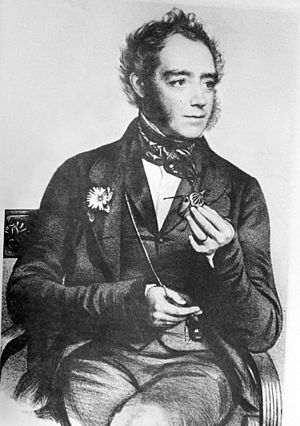John O. Westwood facts for kids
Quick facts for kids
John Obadiah Westwood
|
|
|---|---|
 |
|
| Born | 22 December 1805 Sheffield, England
|
| Died | 2 January 1893 (aged 87) Oxford, England
|
| Nationality | English |
| Known for | Entomology, insect illustrations |
| Awards | Royal Medal (1855) |
John Obadiah Westwood (born December 22, 1805 – died January 2, 1893) was an English scientist who studied entomology (insects) and archaeology (old things and history). He was also a talented artist. He created many books with illustrations of insects and ancient objects. Westwood was one of the first insect experts to have a teaching job at Oxford University.
Contents
Discovering Insects: John Westwood's Life and Work
John Westwood was born in Sheffield, England, into a Quaker family. His father made medals and dies. John went to school in Sheffield and later in Lichfield. For a short time, he trained to be a lawyer, but he soon realized his true passion was elsewhere. He loved studying old English and medieval writings. He made a living by drawing and writing.
A Passion for Insects
In 1824, Westwood met Reverend Frederick William Hope, another insect expert. They became very good friends. In 1833, Westwood and Hope helped start the Entomological Society of London. This is a group for people who study insects. Westwood was the secretary of this society in 1834. Hope asked Westwood to organize his large collection of insects. This allowed Westwood to study and describe insects from all over the world. He focused on larger, unusual, and colorful species.
Teaching at Oxford University
In 1849, Frederick Hope decided to give his insect collections to Oxford University. He arranged for Westwood to become the curator, or caretaker, of these collections. Westwood started this job in 1857. He also gave his own insect specimens to the Hope Collection.
Hope also helped set up a new teaching position at Oxford specifically for entomology. Westwood was chosen as the first Hope Professor in 1861. He received a special degree and joined Magdalen College, Oxford.
Views on Evolution
Westwood was a very religious man. He believed that nature showed God's design. Even though Charles Darwin published his famous book Origin of Species in 1859, Westwood never accepted the idea of evolution. He continued to study insects for more than 30 years after Darwin's book came out. Westwood even thought that some insect resemblances, like mimicry (when one animal looks like another), were just strange natural occurrences, not a result of evolution. He even suggested that Oxford should have a teacher whose job was to argue against Darwin's ideas.
Westwood was one of the first scientists to try and guess how many different kinds of insects there were in the world. He estimated there were about half a million!
Family and Achievements
In 1839, John Westwood married Eliza Richardson. She often went with him on his trips to study old buildings and stones. She helped him make drawings and copies of the writings on these stones for his book, Lapidarium Walliæ.
Westwood was a member of many important scientific groups. He was elected a Fellow of the Linnean Society in 1827. He was also the president of the Royal Entomological Society of London from 1852 to 1853. In 1855, he received the Royal Society's medal for his important work on insects. Even Charles Darwin recommended him for this award. In 1883, he was honored as the honorary life president of the Entomological Society. He also helped gardeners by sharing his insect knowledge in the Gardener's Chronicle newspaper.
Later Life and Passing
In 1884, Westwood had a fall that injured his arm, making it hard for him to continue his studies. On December 30, 1892, he suddenly collapsed after returning from a meeting. He had a cerebral haemorrhage, which is bleeding in the brain. He went into a coma and passed away on January 2, 1893. He was buried in St Sepulchre's Cemetery in Oxford.
John Westwood's Legacy
John Westwood's work is still remembered today. The J. O. Westwood Medal is given out every two years by the Royal Entomological Society in his honor. A type of wasp, called Westwoodia, was named after him in 1846. A part of St Andrew's Church in Sandford-on-Thames was also built in his honor in 1893.
Some of John Westwood's Books
Here are some of the books John Westwood wrote or helped create:
- An introduction to the modern classification of insects. (1839)
- The Entomologists Textbook. (1838)
- Synopsis of the genera of British Insects. (1840)
- The Cabinet of Oriental Entomology (1848)
- Arcana Entomologica, or illustrations of new, rare, and interesting exotic insects. (Volumes 1 & 2, 1841-1845)
- Thesaurus Entomologicus Oxoniensis: or illustrations of new, rare and interesting insects, for the most part coloured, in the collections presented to the University of Oxford by the Rev. F.W. Hope. (1873-1874)
- With Henry Noel Humphreys British Moths and Their Transformations. (2 Volumes, 1843–1845)
- Revisio Insectorum Familiae Mantidarum, speciebus novis aut minus cognitis descriptis et delineatis. (1889)
- Catalogue of the Orthopterous Insects in the Collection of British Museum. Part I: Phasmidae. (1859)



